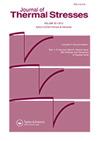Regulatory Effects of GPR158 Overexpression in Trabecular Meshwork Cells of the Eye’s Aqueous Outflow Pathways
IF 2.3
3区 工程技术
Q2 MECHANICS
引用次数: 0
Abstract
Elevated intraocular pressure (IOP), the major risk factor for glaucoma, is caused by decreased outflow through the trabecular meshwork (TM). The pathophysiology of ocular hypertension has been linked to stress pathways, including fibrosis, calcification and the unfolded protein response (UPR). In a pharmacogenomic screen, we previously identified the novel G-protein-coupled receptor (GPCR), GPR158, showed that expression is upregulated in TM cells by glucocorticoid stress hormones, and showed that overexpression protects against oxidative stress. We also found that loss of Gpr158 in knockout mice negates IOP reduction due to treatment with the catecholamine stress hormone, epinephrine. An increase in GPR158 would be expected to alter the activity of GPR158-regulated pathways. Here, we profiled gene expression changes due to GPR158 overexpression by microarray, then conducted pathway analysis. We identified five upstream stress regulators relevant to ocular hypertension: dexamethasone and TGFB1 (fibrosis), XBP1 and ATF4 (UPR), and TP53 (cell cycle arrest). Key genes in the first three pathways were downregulated by GPR158 overexpression, but not enough to inhibit dexamethasone-induced fibrosis or calcification in TM cells, and loss of Gpr158 in knockout mice only minimally protected against dexamethasone-induced ocular hypertension. Depending on dose, GPR158 overexpression down- or upregulated the TP53 pathway, suggesting the mechanism for previously observed effects on cell proliferation. A sixth upstream regulator we identified was a GPCR: the beta-adrenergic receptor ADRB1. Adrenergic receptors serve as targets for IOP-lowering drugs, including epinephrine. These data provide new information about pathways regulated by GPR158.GPR158过表达在眼水流出通路小梁网细胞中的调控作用
眼内压升高(IOP)是青光眼的主要危险因素,是由小梁网(TM)流出物减少引起的。高眼压的病理生理与应激途径有关,包括纤维化、钙化和未折叠蛋白反应(UPR)。在药物基因组学筛选中,我们先前鉴定了新的g蛋白偶联受体(GPCR) GPR158,表明糖皮质激素应激激素在TM细胞中表达上调,并表明过表达可以防止氧化应激。我们还发现,在基因敲除小鼠中,Gpr158的缺失会由于儿茶酚胺应激激素肾上腺素的治疗而使IOP降低。GPR158的增加预计会改变GPR158调控通路的活性。在这里,我们通过芯片分析GPR158过表达导致的基因表达变化,然后进行通路分析。我们确定了与高眼压相关的5种上游应激调节因子:地塞米松和TGFB1(纤维化)、XBP1和ATF4 (UPR)以及TP53(细胞周期阻滞)。GPR158过表达下调了前三条通路的关键基因,但不足以抑制地塞米松诱导的TM细胞纤维化或钙化,基因敲除小鼠GPR158缺失仅对地塞米松诱导的高眼压具有最低程度的保护作用。根据剂量的不同,GPR158过表达下调或上调TP53通路,提示了先前观察到的对细胞增殖影响的机制。我们发现的第六个上游调控因子是GPCR: β -肾上腺素能受体ADRB1。肾上腺素能受体是包括肾上腺素在内的降低内压药物的靶点。这些数据为GPR158调控的通路提供了新的信息。
本文章由计算机程序翻译,如有差异,请以英文原文为准。
求助全文
约1分钟内获得全文
求助全文
来源期刊

Journal of Thermal Stresses
工程技术-力学
CiteScore
5.20
自引率
7.10%
发文量
58
审稿时长
3 months
期刊介绍:
The first international journal devoted exclusively to the subject, Journal of Thermal Stresses publishes refereed articles on the theoretical and industrial applications of thermal stresses. Intended as a forum for those engaged in analytic as well as experimental research, this monthly journal includes papers on mathematical and practical applications. Emphasis is placed on new developments in thermoelasticity, thermoplasticity, and theory and applications of thermal stresses. Papers on experimental methods and on numerical methods, including finite element methods, are also published.
 求助内容:
求助内容: 应助结果提醒方式:
应助结果提醒方式:


